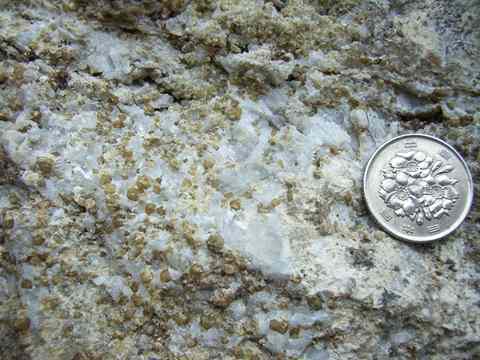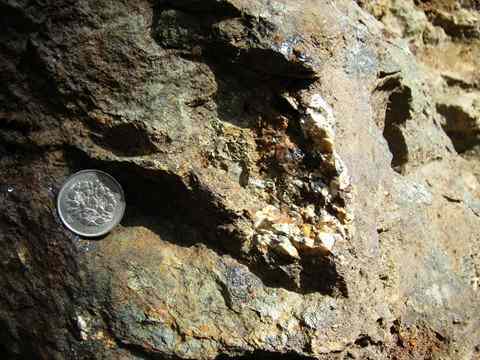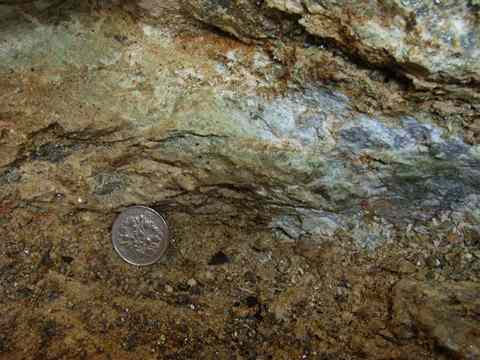Chichibu Mine
Otaki, Chichibu city, Saitama pref., Japan
Occurrence
Moderately low-T hydrothermal skarn deposit
Skarn formed by South Body of Miocene Chichibu Tonalite intruded in Ryokami Unit, a member of Jurassic accretionary complex of Southern Chichibu Belt. The moderate-low temperature hydrothermal deposit associated with the skarn was formed by Miocene quartz porphyry and andesite dykes. The quartz porphyry and andesite dyke are possibly related to Okaburi Formation, Miocene volcanic collapse basin deposit. 6 deposits are distributed from south to north: Nakatsu, Daikoku, Wanaba, Rokusuke, Akaiwa, and Doushinkubo. These deposits are classified to two types: High temperature early stage deposits associated with Sanidinite facies to Pyroxene-hornfels facies skarn and Low temperature late stage deposits associated with Hornblende-hornfels facies to Albite-Epidote-hornfels facies skarn.
Early stage deposits: High temperature massive deposits replacing limestone. Mainly composed of magnetite and pyrrhotite.
>>Doushinkubo deposit: Iron ore, and sulfides ore.
>>Wanaba deposit: Pyrrhotite.
Late stage depoists: Low temperature deposit hosted by limestone. Mainly composed of sphalerite and pyrite.
>>Daikoku deposit: Zinc, sulfides ore, iron ore, and manganese ore.
>>Akaiwa deposit: Zinc, lead, and sulfides ore.

Outcrop of skarn of Ryokami Unit at the Sekkai-zawa creek. The white host is mainly composed of calcite associated with tiny brown grossular crystals.

Outcrop of skarn of the Nakatsu deposit in Ryokami Unit. This outcrop is mostly composed of dark green hedenbergite and black granular magnetite. Huge hydroxylapatite crystals are included as white hexagonal prisms as shown at the right of the scale coin.

Outcrop of skarn of the Daikoku deposit in Ryokami Unit. The outcrop is mainly composed of brown andradite. The yellow spots at the upper left of the coin are pyrite aggregates. The white part at the left is quartz. Gold has been recovered from open spaces of this quartz.
Reported Minerals
- Gold
- Bismuth
- Sphalerite
- Chalcopyrite
- Tetrahedrite
- Pyrrhotite
- Galena
- Stibnite
- Bismuthinite
- Pyrite
- Marcasite
- Arsenopyrite
- Molybdenite
- Berthierite
- Bournonite
- Jamesonite
- Semseyite
- Boulangerite
- Zinkenite
- Spinel
- Magnetite
- Arsenolite
- Hematite
- Oxyplumboroméite (Oxyplumboromeite)
- Quartz
- Allophane
- Goethite
- Limonite
- Magnesite
- Siderite
- Rhodochrosite
- Calcite
- Dolomite
- Ankerite
- Kutnohorite
- Aragonite
- Cerussite
- Azurite
- Malachite
- Anhydrite
- Anglesite
- Melanterite
- Gypsum
- Scheelite
- Ferberite?
- Hydroxylapatite
- Pyromorphite
- Scorodite
- Pharmacosiderite
- Mimetite
- Wulfenite
- Grossular
- Andradite
- Sphene
- Hydroxylellestadite
- Datolite
- Gehlenite
- Bicchulite
- Ilvaite
- Hemimorphite
- Epidote
- Vesuvianite
- Schorl
- Dravite
- Diopside
- Hedenbergite
- Johannsenite
- Actinolite
- Wollastonite
- Bustamite
- Rhodonite
- Pyroxmangite
- Axinite-(Fe)
- Prehnite
- Clintonite
- Illite
- Montmorillonite
- Chlorite
- Nacrite
- Chrysocolla
- Adularia
- Laumontite
- Heulandite
- Chabazite
- Ice/Water
Mineral Assemblages
- (Host side) Kutonohorite - Ilvaite - Hedenbergite/Johannsenite - Sphalerite(Center of vein)
- Grossular - Spinel - Clintonite
- Calcite - Grossular - Diopside - Wollastonite
- Calcite - Grossular - Diopside - Vesuvianite - Epidote
- Rhodochrosite - Sphalerite - Galena - Arsenopyrite
- Calcite - Magnetite - Pyrite - Chalcopyrite
- Calcite - Magnetite - Actinolite
- Quartz(Gangue) - Zinkenite - Sphalerite - Stibiconite - Valentinite - AndoriteVI
- Quartz(Gangue) - Hedenbergite - hydroxylapatite - Magnetite
- Andesite(Host) - Gypsum
Details of the mine
The Chichibu mine was the second biggest iron mine in 1940's. This mine hired 1060 workers at the best days, and mainly produced zinc and iron. It Also produced gold, silver, cupper, lead, metal sulfides, and manganese ores.
Produced metal(April, 1973)
- Copper: 550 tons
- Iron: 6,500 tons
- Limestone: 3,000 tones
- Silica sand: 2,600 tons
History
- 1610: Nakatsu deposit was found. Takeda (King of small country, Kai) mined gold as his resource for wars.
- 1766: Gennai Hiraga, famous scientist in Edo era, tried to mine gold but failed.
- 1783: Started to mine Nakatsu deposit.
- 1826: Kihei Sachijima discovered the Daikoku deposit.
- 1844: Rokusuke deposit was found.
- 1845: Akaiwa deposit was found.
- 1937: The mine was modernized by Nicchitsu Mining corporation, and gold, silver, cupper, lead and zinc were began to mine.
- 1940: The concentrator was built.
- 1945: Temporaly stopped mining because of the end of World War II.
- 1952: Huge zinc deposit was found at Daikoku deposit.
- 1959: Doushinkubo deposit was found.
- 1968: Silica sand was started to mine.
- 1973: It began to reduce the scale of mine.
- 1978: Stopped mining except limestone.
Localities
- Chichibu Mine (Quartz Diorite)